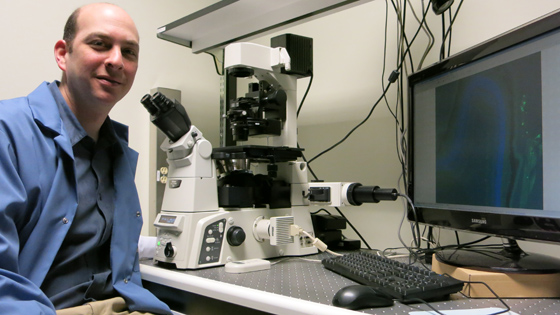
Dr. Jeremy Sivak, Scientist, Toronto Western Research Institute, looks at a retina image used for analysis in his team’s study of the protective properties of the PGC-1α protein (Photo: UHN)
The first thing you do when you wake up is open your eyes. You use them to communicate, learn and engage with your surrounding environment.
What if one day you noticed your vision started slipping away? What if your sight gradually became worse until you couldn't see anything at all?
More than 67 million people worldwide are facing the reality of progressive and irreversible blindness caused by glaucoma, a common eye disease that damages the optic nerve cells. Of these 67 million people, many will still progress under current treatment options.
In research labs at Toronto Western Hospital's Krembil Discovery Tower, a team of scientists are looking for new ways to prevent glaucoma, starting at the root of the problem.
Looking at new ways to prevent glaucoma
"We don't have effective treatments for all patients with glaucoma because little is currently known about the actual mechanism that causes the optic nerve damage," said Dr. Jeremy Sivak, Scientist, Toronto Western Research Institute (TWRI). "Our strategy was to look at the site of injury to identify important changes in gene activity and proteins."
The researchers honed in on the protein PGC-1α, which has been shown to act as a gateway for repair in the brain. They found that populations of cells in the retina – called astrocytes – also contain this protein, which can protect the optic nerve from damage. This discovery means there is potential to develop ways to enable these cells to respond to damage and mediate repair in the retina and hopefully prevent common vision loss disorders like glaucoma.
The findings of this research, summarized in a paper entitled "PGC-1α Signaling Coordinates Susceptibility to Metabolic and Oxidative Injury in the Inner Retina," were published in the
American Journal of Pathology last month.
Sivak sets his sights on a tangible solution
With a background in pharmaceuticals, Sivak has always set his sights on developing a tangible solution for patients with early risk factors.
"Our goal is to increase the quality of life for people living with glaucoma, and prevent the aging population from ever developing it," said Sivak. "The results from the study are promising, so we're looking into the possibility of candidate drugs or gene therapy to increase the PGC-1α protein in the retina, which could help us to achieve this goal."
This research is innovative for glaucoma as it looks at the site where the injury occurs in the eye. Current treatments for glaucoma, such as pressure-reducing eye drops, only reduce one of many factors that increase risk for developing the disease.
While there is no cure for glaucoma, the disease can be controlled for patients who experience a build-up of pressure in the eye. Yet, even these patients can progress to optic nerve damage, and those who don't develop increased pressure currently have no effective treatment options.
World Glaucoma Week
Glaucoma is an invisible, painless disease that goes unnoticed and undiagnosed by many people. The Glaucoma Clinic, part of UHN's Donald K. Johnson Eye Centre, treats more than 5,000 patients per year with the latest technology in optic nerve imaging and visual fields.
March 9-15 is World Glaucoma Week and it's important to raise awareness and educate the public about glaucoma. To learn more about UHN's Glaucoma Clinic, types of glaucoma and treatment options,
click here. To read more about Dr. Sivak's research
click here.
To help in the fight against blindness, you can donate to the
Toronto Western & Hospital Foundation.
